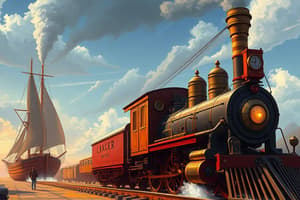Podcast
Questions and Answers
Which characteristic distinguishes the Newcomen Engine from other early engines?
Which characteristic distinguishes the Newcomen Engine from other early engines?
- It was designed for combustion of fuel.
- It utilized steam pressure for rotary motion.
- It created a vacuum from cooled steam. (correct)
- It operated without the need for a condenser.
What advancement did James Watt introduce to improve the steam engine?
What advancement did James Watt introduce to improve the steam engine?
- Implementation of a separate condenser. (correct)
- Utilization of a four-stroke cycle.
- Application of steam to drive locomotives.
- Incorporation of diesel fuel as a power source.
Which engine is recognized as the first practical four-stroke engine?
Which engine is recognized as the first practical four-stroke engine?
- Otto Engine (correct)
- Diesel Engine
- Hero's Engine
- Newcomen Engine
What type of energy conversion occurs in steam engines?
What type of energy conversion occurs in steam engines?
Which aspect of the Diesel Engine contributed to its efficiency over gasoline engines?
Which aspect of the Diesel Engine contributed to its efficiency over gasoline engines?
Which element is not a common component of both steam and internal combustion engines?
Which element is not a common component of both steam and internal combustion engines?
How did early engines impact the Industrial Revolution?
How did early engines impact the Industrial Revolution?
What was a key limitation of Hero's Engine?
What was a key limitation of Hero's Engine?
What was the primary function of the Newcomen Engine?
What was the primary function of the Newcomen Engine?
What legacy did early engines leave for modern technology?
What legacy did early engines leave for modern technology?
Flashcards are hidden until you start studying
Study Notes
Overview of the 1st Engine
- The term "1st Engine" often refers to the first operational mechanical engines in history.
- Early engines significantly contributed to industry and transportation advancements.
Key Historical Engines
-
Hero's Engine (1st century AD)
- Also known as the aeolipile.
- Described by Hero of Alexandria.
- Utilized steam pressure to produce rotary motion.
- Not a practical engine but laid the groundwork for future steam power concepts.
-
Newcomen Engine (1712)
- Created by Thomas Newcomen.
- First successful atmospheric steam engine.
- Primarily used for pumping water from mines.
- Operated by creating a vacuum from cooled steam.
-
Watt Steam Engine (1765)
- Improved upon Newcomen's design by James Watt.
- Introduced a separate condenser, increasing efficiency.
- Enabled steam engines to drive machinery in factories and locomotives.
-
Internal Combustion Engine (19th century)
- Development of engines utilizing fuel combustion.
- Examples include:
- Otto Engine (1876): First practical four-stroke engine fueled by gasoline.
- Diesel Engine (1897): Developed by Rudolf Diesel, more efficient than gasoline engines.
Importance of Early Engines
- Revolutionized industry via mechanization.
- Transformed transportation, leading to the development of railways and automobiles.
- Set the stage for the Industrial Revolution and modernization of society.
Technical Aspects
- Types of Energy Conversion:
- Mechanical to thermal energy (steam engines).
- Chemical to mechanical energy (internal combustion engines).
- Components:
- Combustion chamber (for internal combustion engines).
- Cylinder and piston (common in steam and combustion engines).
Legacy
- Early engines paved the way for modern technology.
- Continued evolutionary progress in engine design leads to advancements in efficiency and sustainability in energy use.
The First Engines
- The term "1st Engine" typically refers to the first successful mechanical engines of history.
- They were crucial in revolutionizing industry and transportation.
Key Historical Engines
- Hero's Engine (1st Century AD)
- Also known as the aeolipile.
- An early steam-powered device that demonstrated the potential of steam power.
- Used steam pressure to produce rotary motion.
- Not a practical engine but showcased the concept of steam power.
- Newcomen Engine (1712)
- The first functional atmospheric steam engine.
- Designed by Thomas Newcomen.
- Primarily used for pumping water from mines.
- Operated by creating a vacuum using cooled steam.
- Watt Steam Engine (1765)
- An improvement on Newcomen's design by James Watt.
- Introduced a separate condenser, greatly increasing efficiency.
- Enabled steam engines to power factory machinery and locomotives.
- Internal Combustion Engine (19th Century)
- Engines that utilize the combustion of fuel to generate power.
- Notable examples:
- Otto Engine (1876): The first practical gasoline-fueled four-stroke engine.
- Diesel Engine (1897): Developed by Rudolf Diesel, more efficient than gasoline engines.
Importance of Early Engines
- Revolutionized industry by introducing mechanization.
- Transformed transportation, leading to the development of railways and automobiles.
- Laid the groundwork for the Industrial Revolution and propelled societal modernization.
Technical Aspects
- Different Types of Energy Conversion
- Mechanical to thermal energy (steam engines)
- Chemical to mechanical energy (internal combustion engines)
- Key Components
- Combustion Chamber ( for internal combustion engines)
- Cylinder and piston (common in steam and combustion engines)
Legacy
- Early engines set the stage for modern technology.
- Continued innovations in engine design strive to improve efficiency and sustainability in energy use.
Studying That Suits You
Use AI to generate personalized quizzes and flashcards to suit your learning preferences.




![Den industriella revolutionen. Källa: Robert de Vries (red.) (2010-10-03). Industriella Revolutionen. SO-Rummet https://www.so-rummet.se/kategorier/historia/det-langa-1800-talet/industriella-revolutionen# [Hämtad: 2025-01-07]](https://assets.quizgecko.com/cdn-cgi/image/width=300,height=200,fit=crop,quality=75,format=webp/quiz/b94967683abe3cda977896a7216f4dd2.jpg)